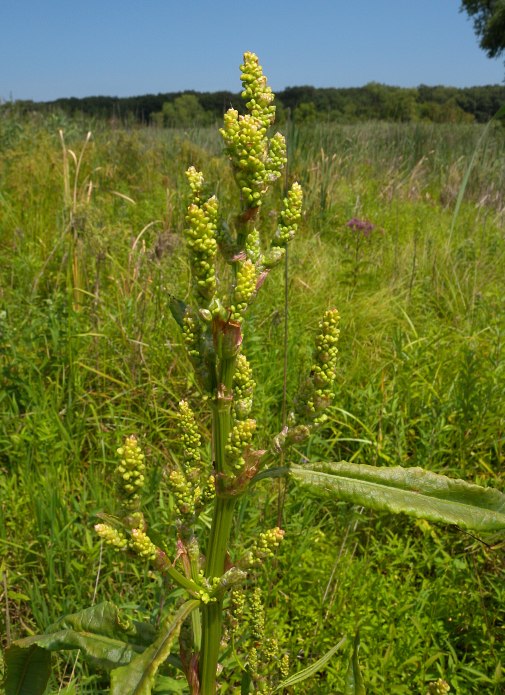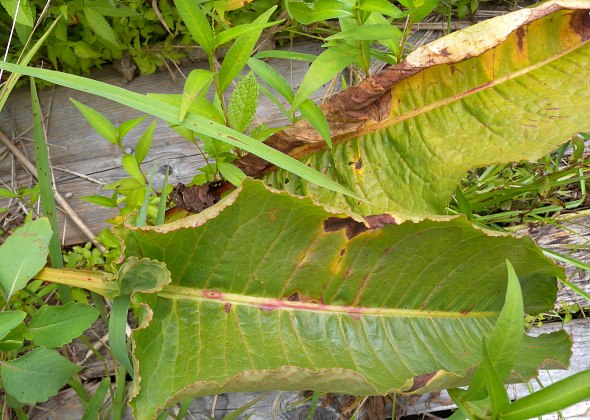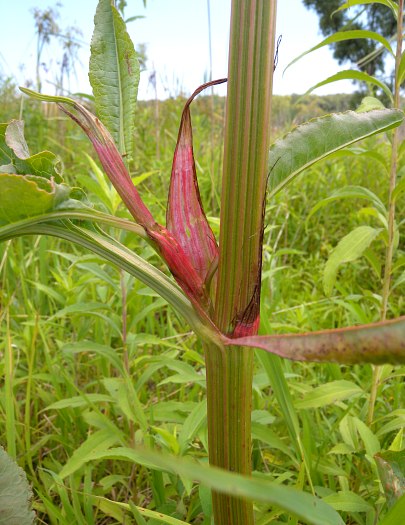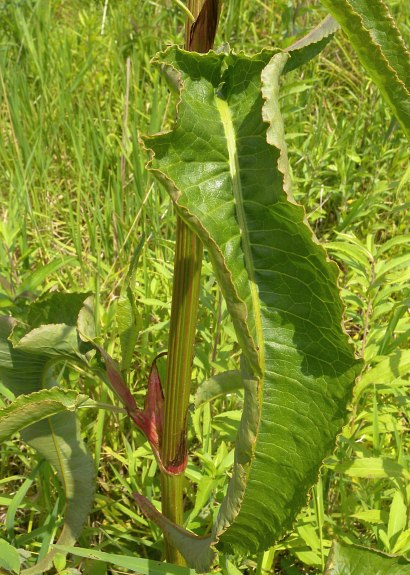
The central stem and lateral stems terminate in panicles of flowers about 4-16" long. Along the stalks (rachises) of panicles, there occurs whorls of 5-25 flowers on drooping pedicels. These whorls of flowers are densely distributed to slightly interrupted along the stalks of mature panicles. The floral stalks have similar characteristics to the stems below, except the former tend to be more narrow in diameter. Each flower is perfect and about 3-4 mm. across, consisting of 3 outer tepals, 3 inner tepals, 6 stamens, and an ovary with a tripartite style. Except for the anthers of the stamens, all parts of the flower are light green to reddish green; they are also hairless. The outer tepals are narrowly oblong in shape, while the inner tepals are more upright and oblong-oblanceolate in shape. The slender pedicels of mature flowers are 5-10 mm. in length, light green, and hairless; they have inconspicuous joints near their bases. The blooming period occurs from mid-summer to early autumn, lasting about 2-4 weeks for a colony of plants. The flowers are cross-pollinated by the wind. Afterwards, the 3 inner tepals of each flower develop into the valves of the fruit, while an achene is contained within a narrowly lanceoloid tubercle along the upper-center of each valve (3 achenes per fruit). The valves of the fruit are light green to reddish green (while immature), orbicular-cordate in shape, and minutely toothed (crenulate-denticulate) along their margins. A network of fine veins occurs across the outer surface of each valve. At maturity, the fruits turn brown and their valves become 4-7 mm. long and a little less across. The achenes of the mature fruits are 3–4.5 mm. long and 1.5–2.5 mm. across; they are reddish brown to brown with a 3-angled ovoid shape. The root system consists of a stout taproot. This plant reproduces by reseeding itself.

Cultivation: The preference is full to partial sun, wet to moist conditions (including very shallow water), and calcareous soil containing considerable organic matter.
Range & Habitat: The native Great Water Dock (Rumex britannica) is occasional in NE Illinois, uncommon in central Illinois, and either rare or absent in the rest of the state (see Distribution Map). This plant occurs primarily in northeastern USA, the Great Lakes region of the upper Midwest, and adjacent areas of Canada. Illinois lies along the southern range limit of this species. Habitats consist of various wetlands, including swamps, cattail marshes, fens, calcareous seeps, low areas along springs, and roadside ditches. Great Water Dock usually occurs in higher quality natural areas.

Faunal Associations: Many kinds of insects feed on the foliage, seeds, roots, etc., of dock species (Rumex spp.). Insects that occur in wetlands are especially likely to feed on Great Water Dock (Rumex britannica). Examples include the larvae of Lycaena hyllus (Bronze Copper) and other Copper butterflies, flea beetles (Mantura spp., Chaetocnema concinna), Lixus concavus (Rhubarb Weevil) and other weevils, maggots of Contarinia rumicis (Dock Seed Midge), Poecilocapsus lineatus (Four-lined Plant Bug) and other polyphagous plant bugs, Dysaphis radicola (Apple-dock Aphid) and other aphids, larvae of Ametastegia glabrata (Dock Sawfly) and other Ametastegia spp., larvae of Phragmatobia fuliginosa (Ruby Tiger Moth) and other moths, and leaf-mining maggots of Pegomya bicolor (an Anthomyiid fly); see Opler & Krizek (1984), Harms & Grodowitz (2009), Vestal (1913), Felt (1917), Knight (1941), Blackman & Eastop (2013), Smith (2006), Covell (1984/2005), and Needham et al. (1928). The seeds of dock species are eaten by many granivorous songbirds, including the Swamp Sparrow, Song Sparrow, Bobolink, and Red-winged Blackbird. These plants are also a source of food for the Meadow Vole and Muskrat (Martin et la., 1951/1961; Hamerstrom & Blake, 1939).

Photographic Location: A fen at Cowle's Bog in NW Indiana.
Comments: Great Water Dock (Rumex britannica) is one of the larger dock species (Rumex spp.) in Illinois. It is non-weedy and occurs in wetlands. In general, Great Water Dock can be distinguished from other dock species by its large size, strong preference for higher quality wetland habitats (at least in Illinois), the large size of its lower leaves (up to 12" long and 4" across), the finely toothed (denticulate) and crisped margins of its leaves, the nearly perpendicular lateral veins of its leaves (relative to the central veins), and more technical characteristics of its 3-valved fruits. The valves of its fruits are minutely toothed along their margins, rather than spiked or toothless. In addition, the valves of its fruits are more orbicular in shape than those of many other dock species. Both valves of its fruits and its achenes tend to be a little larger in size than most dock species in Illinois, and Great Water Dock has fruits with 3 achenes each, rather than a single achene per fruit. A scientific synonym of this plant is Rumex orbiculatus.